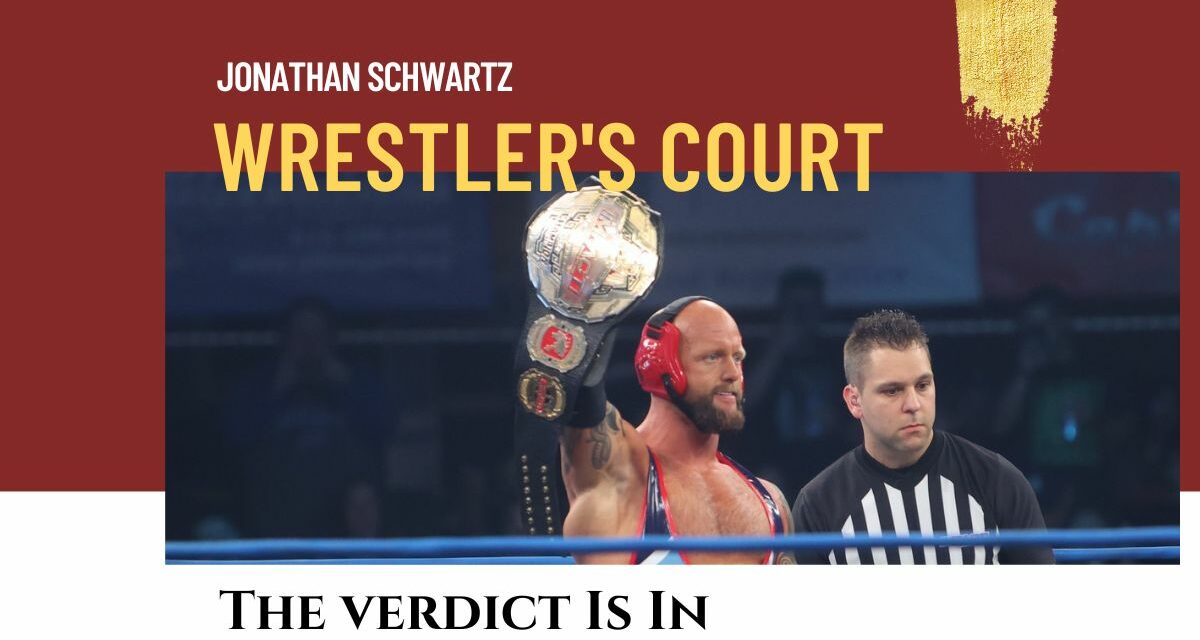I admit, I’ve never understood wrestling journalism’s obsession with television ratings. With apologies to the many more serious writers who’ve come before me, as a fan I’m most interested in the show itself-the storylines and the quality of the wrestling that I consider myself lucky to watch for free. I’ve never been much of a joiner, so as far as I’m concerned the greatest relevance of TV ratings lies in the likelihood my favorite program will be cancelled. But then I still hold out hope that The Adventures of Brisco County, Jr. will get a reboot (seriously, if you’re a Bruce Campbell fan, check it out; it was awesome).
Media observers like Chris Cruise suggest that professional wrestling is in decline generally; party to the same death spiral that caught roller derby decades ago. While pro wrestling’s TV ratings are less healthy than they were 25 years ago (coincidentally when he was employed in the field), the entertainment world has fragmented. The Monday Night Wars took place before the 500 channel universe was a reality — and in my area Impact airs on Channel 537. Wrestling’s last moment of broad cultural relevance also happened in the early days of the Internet, before endless podcasts (like Wrestling and Everything, where I appear frequently) and shoot interviews and spoilers and endless dissections of the business; also well before live-streaming was a thing and, to say nothing of the prevalence of online subscription services and internet networks.
Perhaps Vince McMahon’s greatest contribution to pro wrestling was his ability to anticipate these changes and find a place for WWE in new media as an early adopter — first with the eponymous WWE Network and later when he licensed WWE content to NBC’s Peacock network — while still being shrewd enough to keep his flagship properties, Monday Night Raw and SmackDown on basic cable and network TV (Vince has bet wrong too … anyone remember Tout?). From a media saturation perspective, WWE seems to have its bases covered. AEW with its own cable and YouTube based platforms is not far behind. Raw, Smackdown and AEW Dynamite routinely pull at least one million viewers each. It’s nowhere close to WWE’s late 1990s numbers, but it keeps the lights on.
Today, TV numbers don’t tell the full story. On November 27, Triple H spoke at a biting-free press conference following the Survivor Series: War Games event. He was quick to claim that this year’s event was the highest grossing and most watched ever. These claims are mired in the fact that WWE’s approach to service delivery changed drastically when they moved away from $50 pay per views to including them for free as part of an annual subscription service.
Impact offers its own subscription service featuring its pay per views, video from past events and new content. It also maintains an Impact YouTube feed. On November 29 (the day before I wrote this column), Impact announced an international distribution partnership with the DAZN streaming service, which it claims will bring Impact to more than 170 countries.
All of which is not to say that Impact is doing great on the numbers front. In 2022 Impact’s flagship program audience was an order of magnitude smaller than AEW Dynamite’s. With the exception of January 24-28, when it attracted 180,000 viewers, Impact’s audience has hovered around 100,000 viewers. This means that despite reaching a potential audience of millions, the number of fans who tune in on average to Impact programming could probably cram into WWE’s most recent WrestleMania location: AT&T Stadium in Dallas.
Impact airs on AXS TV and here in Canada, on the Fight Network, all of which share the same corporate parent, the Toronto-based Anthem Sports & Entertainment. It’s a far cry from the promotion that filmed in arenas during Dixie Carter’s ownership, but hopefully keeps Anthem going since now, as ever, pro wrestling provides an inexpensive source of content for broadcasters.
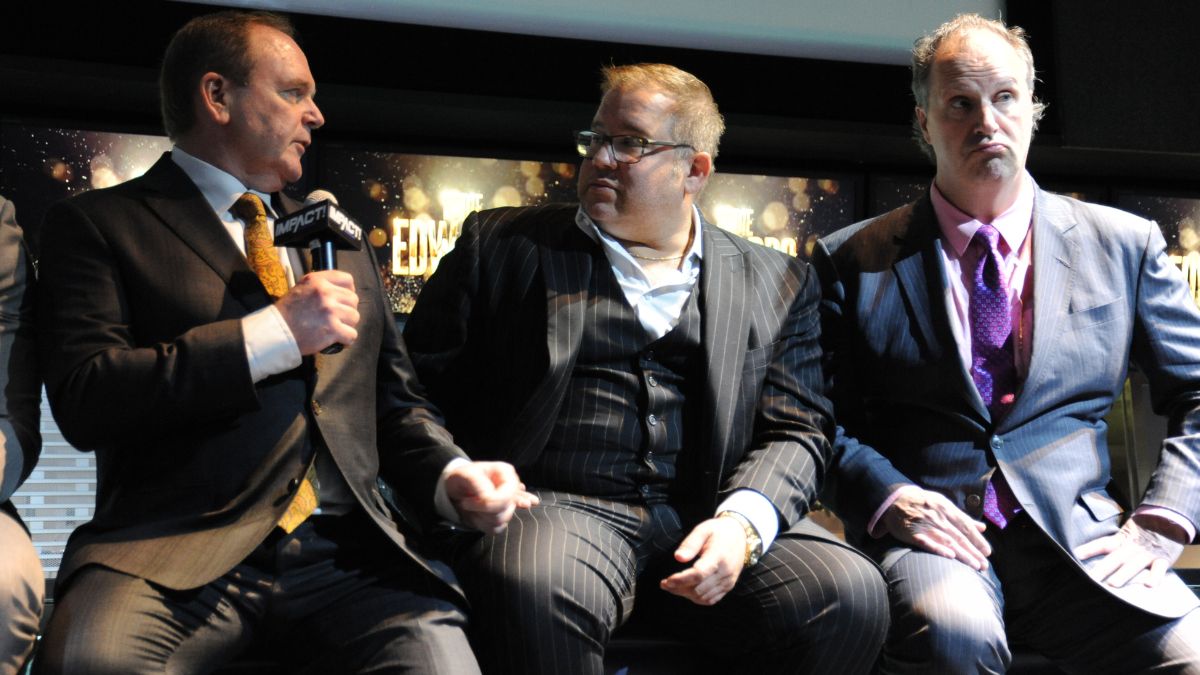
Ed Nordholm, Scott D’Amore and Don Callis at an Impact press conference in Toronto in June 2018. Photo by Mike Mastrandrea, www.mikemastrandrea.com
I’m tempted to provide a bit of historical context, but in Impact’s case it feels irrelevant. Impact was founded 20 years ago, in 2002. Since then it has gone through a litany of owners including Jeff and Jerry Jarrett, Dixie Carter and now Anthem. It has also gone through several name changes from its earliest positioning as the NWA’s flagship promotion, to “Total Nonstop Action” (fun fact: when original TNA booker Vince Russo — who I think is criminally underrated — first came up with the name, he meant for “TNA” to have its more conventional meaning, and for the show to feature much more gratuitous sex and violence. There but for the grace of God…), to Impact to Global Force Wrestling (as part of an attempted coup by the long-ousted Jarrett) and back to Impact. Today Leonard Asper is the President and CEO or Anthem, Ed Nordholm is the president of Impact itself, and Scott D’Amore is the Head of Creative — a job he used to share with Don Callis until the latter left following allegations of harassment against female talent. Today’s Impact occasionally employs some legacy talent, but corporately it’s a different animal entirely.
In many ways, Impact arose from the ashes of WCW. Talent like Jeff Jarrett who were unlikely to find work with the WWF needed a place to ply their trade. Despite limited capital, they put on good shows, leveraging weekly pay per views until they were able to find a spot on television and occasionally tour. In the absence of anyone else Impact swiftly became the second biggest American promotion, offering a different product from the WWF, which was becoming stale, featuring rehashed ideas and pushing the same few characters well past their sell date. Early TNA episodes were uneven and featured some ridiculous, bizarre and offensive characters and storylines (see: Russo, Vince) but credit goes to their efforts to get noticed in a growing media universe and a burnt-out fan base.
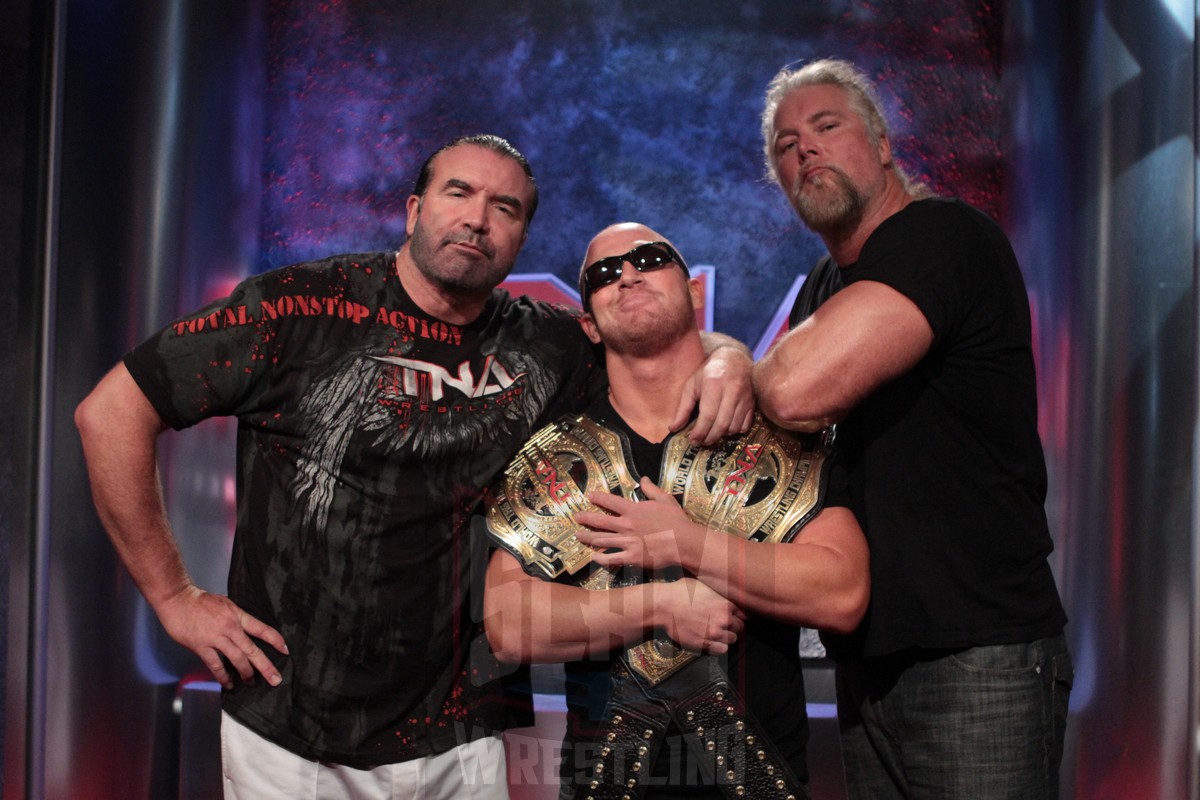
Scott Hall, Eric Young and Kevin Nash at TNA. Photo by George Tahinos, https://georgetahinos.smugmug.com
At its best, TNA relied on then-unknown talent like AJ Styles, Christopher Daniels, Austin Aries and Samoa Joe to build its brand. At its worst, TNA barred those and other talent from working for other promotions like Ring of Honor and eventually decided to go all in with a WCW impersonation by remaking the program to feature Hulk Hogan and his cronies. Even worse, Impact thought it could take the momentum it had and challenge WWE directly. Impact got creamed. I’ve written before about the fallacy that there can only be one major wrestling federation. Fandom should be big enough to embrace different promotions with different styles, with more choice for fans and more places for wrestlers to work. For a promotion that was building its own brand, this proved a near-fatal mistake. Fans tuned out in droves, preferring ‘homegrown’, younger and more wrestling-centered talent to an emphasis on storylines with Hogan, Scott Hall and Kevin Nash, Ric Flair and Mick Foley — all of whom could still cut promos but none of whom belonged in the ring (and still don’t). Money troubles followed, and today the promotion has been bypassed by AEW and seems to be duking it out with Billy Corgan’s NWA for the #3 spot in the US.
If your eyes haven’t glazed over at the business end of things, I’ll tell you why I’m writing about Impact.
It’s the wrestling.
In my last column I bemoaned the NWA’s creative choices and their clout chasing decision to make Tyrus champion. Impact is choosing a different path. Its roster is smaller and features a different mix of former and future WWE and AEW stars. With ROH subsumed into AEW, it seems like Impact now occupies the slot where, between creative contracts and a liberal intellectual property policy, it has become the preferred destination for talent in the process of moving from one big US fed to the other, or else from North America to Japan.
The Good Brothers (Luke Gallows and Karl Anderson) moved to Impact after their contentious release from WWE. They elevated their stock by rekindling their Bullet Club cred and engaging in solid matches against the likes of the Motor City Machine Guns and the Briscoe Brothers. So much so that they made it back to WWE and AJ Styles’ welcoming arms.
Bronson Reed, an athletic big man act that reminds me of Bam Bam Bigelow and Vader, was inexplicably released despite a strong push in NXT and a few main roster auditions on Main Event. He debuted in Impact as Jonah for a shorter but memorable run that included a violent series of matches against PCO. Jonah has parlayed his time in the wilderness into a huge New Japan run as well, beating the likes of Kazuchika Okada. It may be a matter of time until he heads back to WWE too.
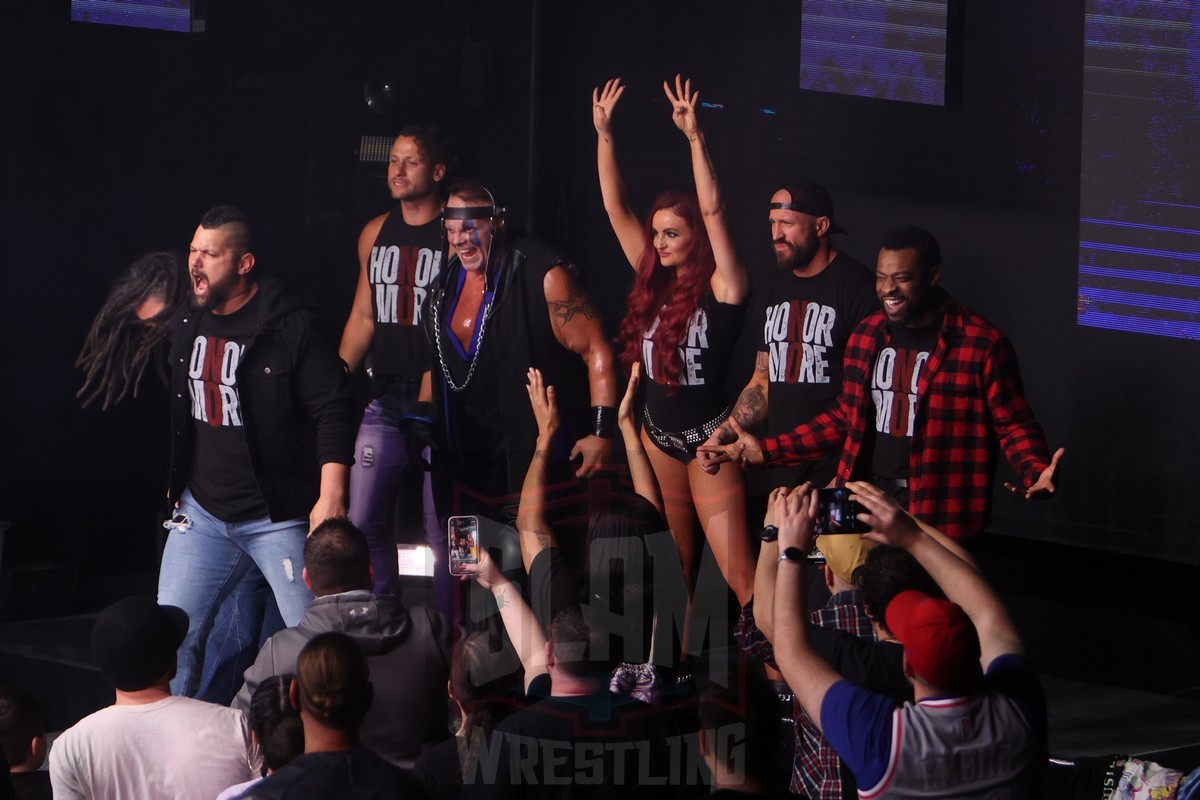
Honor No More — Eddie Edwards, Matt Taven, PCO, Maria Kanellis, Mike Bennett and Kenny King — on Impact Wrestling, airing on April 14, 2022, taped in Philadelphia at the 2300 Arena. Photo by George Tahinos, https://georgetahinos.smugmug.com
When ROH initially folded several stars, including Maria Kanellis and Mike Bennett, who had been burned by their recent WWE runs, opted to join Impact. Alongside fellow Kingdom members Matt Taven and Vincent, plus Kenny King and PCO, they formed a stable of disaffected ex-roster members called Honor No More. The group quickly gained a leader in Eddie Edwards and set about terrorizing supposed Impact stalwarts. It was a fun twist on the old invasion angle. It was more believable than some *cough* *WCW* *cough* *ECW* because it capitalized on the actual death of promotion and kept the in-ring talent front and center … and each member of Honor No More could put on an entertaining match. It lacked a certain degree of logic. Most of the Honor No More crew had previous Impact runs, and in some cases had spent time in WWE. Impact’s defenders at points included Chris Sabin, Alex Shelley, Rhino, Heath, Willie Mack, and Rich Swann … all of whom had similar histories with other promotions.
And that may be how, after earlier misguided attempts to challenge the big companies, Impact has survived. It keeps a few lynchpin wrestlers on longer contracts when it can, but most talent work on per-appearance contracts. This minimizes Impact’s obligations and provides some continuity to its cards, while leaving the audience wanting more as those shorter-term talents pass through.
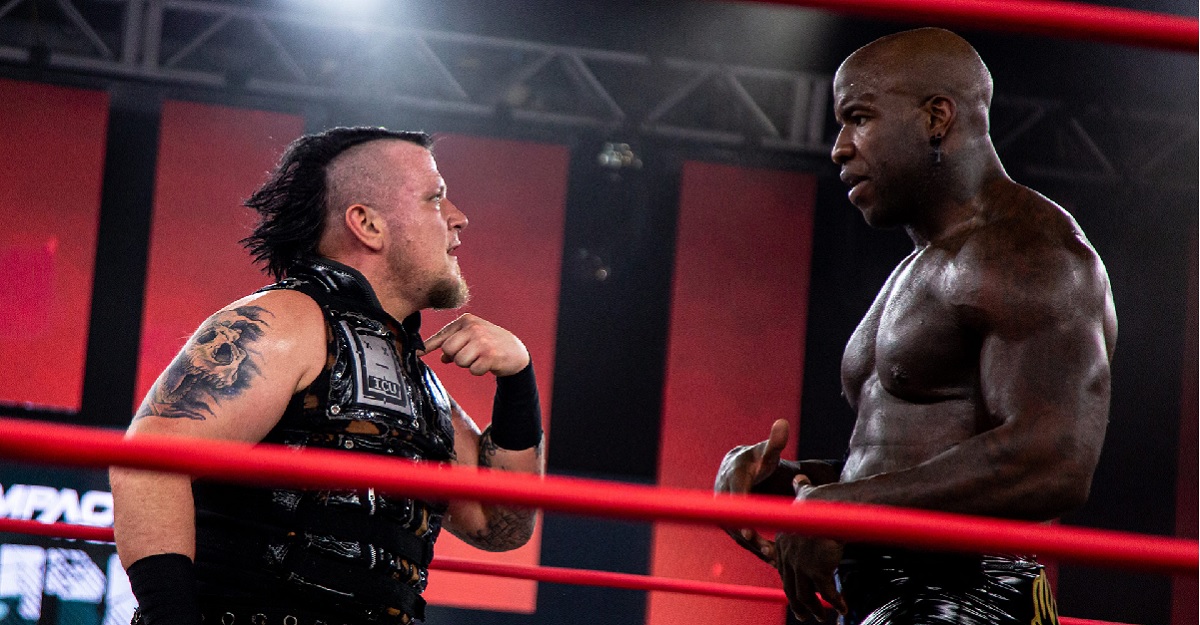
Sami Callihan and Moose in Impact.
Veteran talents like Moose and current champion Josh Alexander and Sami Callahan are worth some investment. They draw interest and can pull good matches out of lesser opponents and be elevated by excellent wrestlers. Wrestlers are allowed to hold onto their intellectual property — a major stumbling block in WWE, which often insists on rebranding their talent, to the point that they’ll ruin an act that works. Impact came to this realization following a dispute with Matt Hardy, who had a tremendous run with his “Broken” character but was initially prevented from bringing it to WWE. Without Hardy himself the “Broken” IP meant nothing. Glenn Jacobs and Rick Bogner could tell you that. Allowing Impact talent to share hot acts elsewhere could only whet viewers curiosity to check out their broadcasts. And Impact needs all the eyeballs it can get.
Impact’s broadcasts are comparatively basic. The storylines are mostly linear; based on titles and personal issues, just like Jim Ross would want it. I’m the first to admit that the storylines are often weird or hokey, but that’s looking at them with adult eyes. As a kid I bought into Papa Shango making the Ultimate Warrior vomit. As a younger adult I thought the Boogeyman was dumb. As a grownup I love Bray Wyatt’s creepiness. But I’d argue Impact’s weirdness even trumps WWE’s since it is done on a tiny budget. If an Impact wrestler is going to enter a dimensional porthole, he’ll do it with a smoke bomb and cheesy Power Point style editing, and he’ll sell the heck out of it. I appreciate the “Let’s put on a show” ethic of these broadcasts — it’s wrestling by way of Roger Corman and occasionally Russ Meyer. I also still love The Muppets.
Chris Bey at the Icons of Wrestling Convention & Fanfest on Saturday, December 18, 2021, at the 2300 Arena, in Philadelphia, PA. Photo by George Tahinos, https://georgetahinos.smugmug.com
The matches themselves are solid to great. Interference ruins some finishes, but that’s to be expected on free TV. The roster is fluid because relatively few wrestlers have long-term contracts. It tends towards smaller, more athletic wrestlers who mix catch-as-catch can with acrobatic moves reminiscent of the Matrix. More experienced wrestlers like Eric Young, Rhyno or Bully Ray (OK, him I can do without) are positioned to help get younger talent over. Wrestlers like Chris Bey or Ace Austin — who enjoy Bullet Club rub — or Rich Swann, Trey Miguel and Mike Bailey all get plenty of time to show what they can do in featured matches.
This smaller, more athletic style adds another dimension to the broadcast when Impact builds a monster. Lance Storm explained this well on his podcast a few years ago. ECW had a smaller roster, which made bigger, more muscular stars like Mike Awesome look fearsome. It also gave him license to throw his opponents around. Awesome floundered in WCW and WWE in part because he was no longer the biggest guy in the yard. He didn’t look as special and was prevented from executing his flashiest moves (like a powerbomb from the ring to the floor) because he couldn’t execute them on people his size or bigger. Mr. Storm (who coincidentally now works as an agent for Impact) points out that while Awesome could throw Spike Dudley across the ring, there’s no way he’d get The Undertaker to agree to a blind landing through a table to the concrete, even if Awesome could credibly get him there.
Currently, W. Morrissey is signed with AEW as part of Stokely Hathaway’s Firm. I don’t think he gets that shot without his work on Impact, with a team of gymnasts bumping across the ring for him.
I would also be remiss if I didn’t note that Impact has long had a strong women’s division, going back to the days of Dixie Carter’s ownership. The Knockouts were positioned as wrestlers deserving of their own storylines and with value placed on their championships at a time when WWE was hiring fitness models to have affairs with Mr. McMahon (art imitating life?). The X Division has also provided a forum for Impact’s most athletic talent since the promotion’s beginnings; I’d argue it has been essential to changing the way we think about wrestling today in everything from the WWE’s attempt to bring back cruiserweights to the current success of stars like AJ Styles (probably Impact’s greatest representative) and Finn Balor. The X Division offered and continues to provide a peek at wrestling’s evolution.
In fairness, all of this fails to account for how Impact remains on the air. I mentioned the cheap content thing and acknowledge that the shows look it. If I were to pick on one thing, it’s the physical setup for the Impact broadcasts. Today Impact runs small venues and seems to have trouble filling them. You can count the rows of seats and often see many that are empty. The ring is also on the small side. I’m glad Impact went back to the four-sided version instead of its signature six-sided ring. The wrestlers seem cramped in their space and limited by the lack of runway. This is particularly evident when talent from other promotions like NJPW or AEW appear on Impact shows. Frankie Kazarian worked a prelim match in Toronto for AEW back in October in a larger, filled-to-capacity space in front of a hot crowd. He recently challenged Impact World champion Josh Alexander for his title. A match that should have had a big event feel was stifled by the small venue and a crowd that just lacked the bodies to generate sufficient heat. NJPW recently sent Aussie Open — two members of its United Empire stable who work a mind-blowing style — but their matches felt constrained without space to work or an audience to feed off. Even if they were working hard, it still felt like they were going half-speed compared to their next level work alongside Will Ospreay against the Elite and Death Triangle in AEW.
So, what keeps Impact going apart from my encouraging you to watch?
I posit a conspiracy theory (don’t worry, I’m not going all Brian Kendrick on you). Longtime wrestling fans will remember that Paul Heyman’s ECW was rarely financially solvent. It stayed in business as long as it did because Heyman had worked a backroom deal with WWE to keep the smaller promotion afloat. It was a cagey move, as it turned ECW into a pipeline where disgruntled and underused WCW talents could reinvent themselves and become more marketable to WWE. I have written before about how Steve Austin, Mick Foley, Brian Pillman and others went from midcarders to Attitude Era main eventers. I don’t think that happens without their sojourns to the Land of Extreme. I would suggest that something similar might be happening with Impact, only Jacksonville is footing the bill instead of Stamford. Impact has developed working relationships and participated in talent exchanges with both AEW and NJPW — the latter particularly surprising since NJPW executives had sworn off dealing with TNA (as it then was) over its mistreatment of current superstar Okada. Impact executive Don Callis jumped ship for an onscreen role with AEW as part of Kenny Omega’s retinue — although there may be other reasons for that. Omega beat Impact champion Rich Swann for Impact’s World championship, defended it on AEW and dropped it to another AEW star, Christian Cage, before it found its way back to a full-time Impact roster member. Kazarian came out of relative obscurity in AEW to challenge Alexander and is still part of the AEW roster. The Good Brothers went back and forth. Purely idle speculation on my part, but something tells me Impact’s doing all of this for more than exposure on another network.
I think it’s part of how Impact will survive until, like ROH it is bought out.
In the meantime (and in between time) I’m enjoying the ride, and I suggest that you do too.
TOP PHOTO: Impact World champion Josh Alexander at Bound For Glory in October 2022. Photo by George Tahinos, georgetahinos.smugmug.com
RELATED LINK
